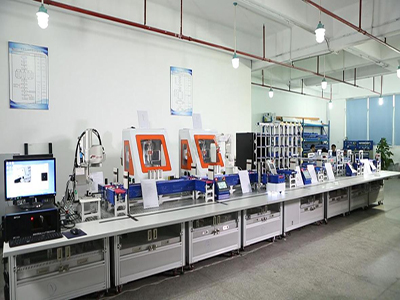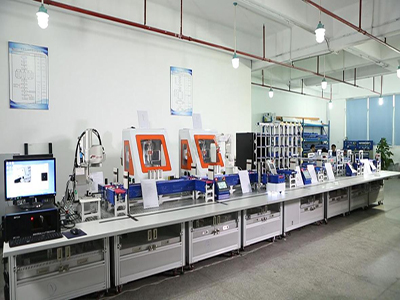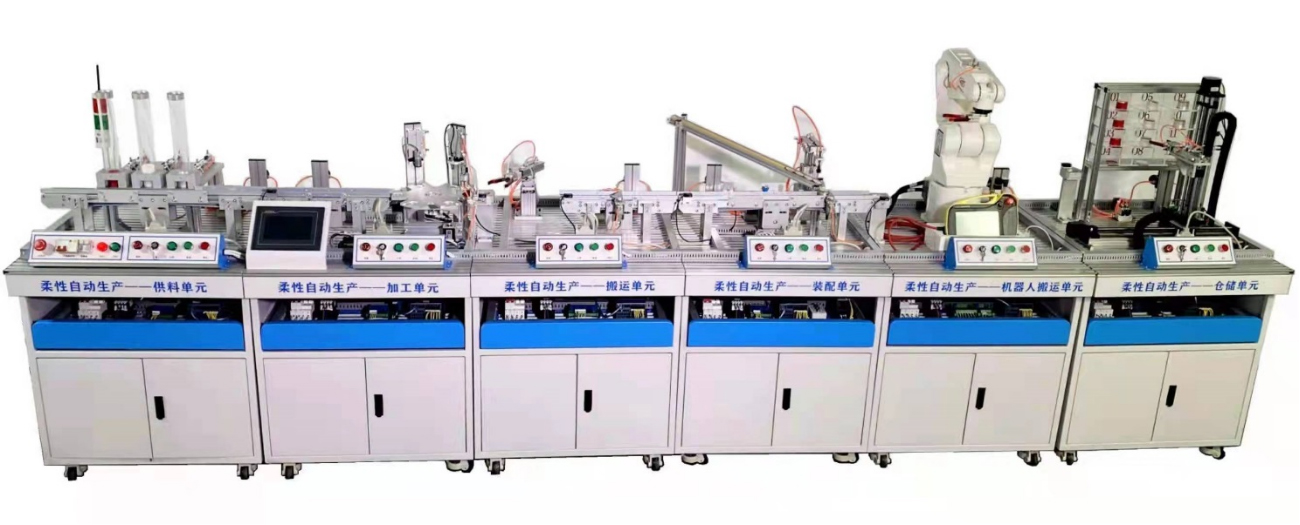This intelligent manufacturing factory training platform is based on a simulated automated production line, integrating information and communication technologies such as ERP, MES, RFID, industrial Ethernet, and fieldbus technology. It also uses intelligent cloud technology to achieve interconnection between demand, production, and supply in the simulated automotive ecosystem, ultimately achieving fast, effective, and intelligent personalized product supply.
GLCG-IM-2 Intelligent manufacturing factory training platform
Ⅰ、Automated three-dimensional storage unit
1.1 Automated three-dimensional warehouse, 1 set
(1) Storage space size: 250×250×250mm (length, width and height);
(2) Overall dimensions: 1800x980x1980mm (length, width and height)
(3) Equipped with 20 pallets.
1.2 Stacker system, 1 set
(1) Travel speed 40m/min Travel motor is 750W servo motor, lifting speed 30m/min Lifting motor is 750w servo motor;
(2) Loading capacity: 30 kg;
(3) Electrical control and system matching, AC220 power supply, PLC control, 24V DC/DC/DC and 16DI/16DO expansion module, matching voltage conversion module, matching 7-inch industrial touch screen;
(4) Program includes: logic control and communication functions, supporting electrical debugging, stand-alone operation and online operation.
1.3 Loading and unloading platform, 2 units
(1) Working length 700mm; Working height 750mm;
(2) Payload: 30KG;
(3) Speed: 12m/min;
(4) Equipped with photoelectric non-contact sensor and RFID reader installation position.
1.4 RFID radio frequency identification system, 2sets
(1) Frequency range: 860Mhz-960Mhz;
(2) Built-in dual-feed ceramic antenna;
(3) Standard interface: RS232, RJ45;
(4) Communication rate: 9600~115200bps;
(5) General purpose input/output (GPIO): 2inputs, 2outputs;
(6) Reading distance: The distance can be controlled at 10cm-100cm and can be set arbitrarily;
Ⅱ、AGV unit of this intelligent manufacturing factory training platform
(1) The top of the AGV carries a belt line platform, which can automatically dock with the production line conveyor belt to complete automatic loading and unloading of materials, and realize the turnover of workshop materials with high efficiency;
(2) Support full-function docking with scheduling system FMS/MES and other systems;
(3) Navigation type: laser SLAM navigation;
(4) Drive form: servo motor differential drive;
(5) Travel mode: forward, backward, bifurcated turning, timed stop, reversing operation and other multi-function travel;
(6) Travel speed: 0~1.2m/s;
(7) Rated load: 100KG;
(8) Endurance time: 4h;
(9) Communication network: WIFI network.
Ⅲ、CNC lathe processing unit of this intelligent manufacturing factory training platform
3.1 1 CNC lathe
(1) Maximum rotation diameter on the bed: φ360mm;
(2) Maximum rotation diameter on the pallet: φ240mm;
(3) X/Z maximum stroke: X400mm/Z280mm;
(4) X/Z fast moving speed: X16m/min Z18m/min;
(5) X/Z repeat positioning accuracy: X±0.001mm /Z±0.0015mm;
(6) Tailstock: pneumatic automatic tailstock, stroke 50mm;
(7) Spindle speed: 1~2500RPM;
(8) Spindle motor power: 3.0KW;
(9) Electric tool holder station: 4 stations, including 4 turning tools;
(10) System: domestic CNC system.
3.2 1 set of six-axis collaborative robot system
(1) Degree of freedom: 6;
(2) Maximum radius: 922mm;
(3) Repeatability: ±0.03mm;
(4) Wrist load: 5kg;
(5) Typical peak power: about 314W;
(6) Control box I/O port: 16 digital input/output (DI/d0), 2 analog input/output (AI/AO);
(7) Control box standard communication: I/O, TCP/IP, Modbus_TCP/RTU and other protocols;
(8) Software development kit: C#/C++/Python/ROS/ROS2;
(9) Teaching pendant: 10.1 inches;
(10) End effector: equipped with quick-change device and 2 sets of pneumatic clamps as required;
3.3 Car-adding unit conveyor line (A), 2 lines
(1) Driven by AC reduction motor, single-phase (220±5% /50Hz) power supply;
(2) Adjustable platform height, effective working width 200mm; working length 700mm; working height 750mm;
(3) Payload: 30KG;
(4) Speed: 12m/min;
(5) Equipped with photoelectric non-contact sensor and RFID reader installation position.
3.4 Vehicle plus unit electrical control cabinet: 1 set
(1) Includes: PLC, HMI, DC power supply and relay;
(2) Equipped with PLC control system, equipped with I/O module;
(3) The touch screen adopts a 7-inch capacitive screen; the control module is installed on a back panel, and a blocking door is installed in front;
(4) The program includes: logic control and communication functions, supporting electrical debugging, stand-alone operation and online operation;
(5) Use Ethernet communication protocol for communication;
(6) Software function: realize line module reading and control execution according to the scheduling layer information, and upload the input point information to the scheduling layer.
3.5 RFID radio frequency identification system, 2 sets
(1) Frequency range: 860Mhz-960Mhz;
(2) Built-in dual-feed ceramic antenna;
(3) Standard interface: RS232, RJ45;
(4) Communication rate: rate 9600~115200bps;
(5) General input/output (GPIO): 2 inputs, 2 outputs;
(6) Reading distance: The distance can be controlled at 10cm-100cm and set arbitrarily;
(7) Provide API development kit and application routines;
3.6 Workbench, 1 set
(1) Overall dimensions 1200*1200*700mm;
IV、CNC milling unit
4.1 Machining center, 1 set
(1) XYZ Axis effective stroke: 340*300*170mm;
(2) Spindle power: 2.2KW;
(3) Spindle speed: 24000rpm/min;
(4) Positioning accuracy: ±0.01mm;
(5) Repeatability: ±0.01mm;
(6) Rapid traverse: 6000mm/min;
(7) Drive motor: 400W;
(8) System: Domestic CNC system;
(9) Maximum tool clamping diameter: ≥12mm;
4.2 Six-axis collaborative robot system, 1 set
(1) Degree of freedom: 6;
(2) Maximum radius: 922mm;
(3) Repeatability: ±0.03mm;
(4) Wrist load: 5kg;
(5) Base diameter: 149mm;
(6) Control box I/O port: Digital input/output (DI/d0) 16 channels , analog input/output (AI/AO) 2 channels;
(7) Software Development Kit: C#/C++/Python/ROS/ROS2;
(8) Teaching pendant: 10.1 inches;
4.3 Milling unit conveyor line, 2 lines
(1) AC reduction motor drive, single-phase (220±5% /50Hz) power supply;
(2) Platform height adjustable, effective working width 200mm; working length 700mm; working height 750mm;
(3) Payload: 30KG;
(4) Speed: 12m/min;
(5) Equipped with photoelectric non-contact sensor and RFID reader installation position.
4.4 Milling unit electrical control cabinet, 1 set
(1) Including: PLC, HMI, DC power supply and relay;
(2) Equipped with PLC Control system, equipped with I/O module;
(3) The touch screen adopts a 7-inch capacitive screen; the control module is installed on a back panel with a blocking door in front;
(4) The program includes: logic control and communication functions, supporting electrical debugging, stand-alone operation and online operation;
4.5 RFID radio frequency identification system, 2 sets
(1) Frequency range: 860Mhz-960Mhz;
(2) Standard interface: RS232, RJ45;
(3) Communication rate: rate 9600~115200bps;
(4) General input/output (GPIO): 2 inputs, 2 outputs;
(5) Reading distance: The distance can be controlled at 10cm-100cm and can be set arbitrarily;
4.6 Workbench, 1 set
(1) Dimensions 1200*1200*700mm;
Ⅴ、Central Control Unit of this intelligent manufacturing factory training platform
(1) 2U rack-mounted, Xeon 4310*2, 32G*2 memory, 3*4TB SAS/H345, network card: 4-port Gigabit network card; optical drive: DVD-ROM; system: support server2019 standard version; power supply: dual hot-swappable redundant power supply;
(2) 48-port Gigabit switch, Category 5e network cable or above (support Gigabit network).
(3) 1 cabinet, size 600*800*1600mm, mesh front door;
(4) 2 dedicated control machines, CPU is 14th generation i5-14400, 16G memory, 1TB HDD+512G SSD, 23-inch display;
Ⅵ、FMS intelligent manufacturing scheduling control system
(1) Receive job instructions from top-level business process software systems such as MES, form job instructions, and distribute them to various automation PLC systems;
(2) The system has an intelligent scheduling control algorithm, which can intelligently schedule unit equipment to perform tasks according to actual production conditions to achieve optimal control of the system; it supports the control of unit equipment such as robots, visual systems, PLC systems, AGV carts and CNC systems, and the system has powerful expansion functions;
(3) AVG scheduling control function, controls the operation of AVG carts to simulate processes, and supports online management of no less than 3 AGV carts. Real-time display of the current position, operating status, scheduling status, and target site of the cart; it can control the car's fixed-point movement, differential movement, directional movement, inbound, outbound,
turning and other functions. Each AGV cart must have an independent and complete control interface and function.
(4) RFID equipment data management, view the status of all RFID scanning points on the production line, obtain their data, and perform route management;
(5) Industrial robot control function, which can teach industrial robots production actions, control flipping status, starting position, target position, and handling objects;
(6) Production line equipment management, production status collection of production line equipment, and display of real-time status;
(7) System status management, including but not limited to PLC information, PLC type, PLC IP address, PLC ROCK ID, PLC SLOT ID.
(8) System settings, used to connect to the factory and display factory information.
Ⅶ、MES Intelligent Manufacturing Execution System
7.1 Distributor order management
7.2 Production order management
7.3 Intelligent warehouse management
7.4 Production process management
7.5 User management
7.6 Factory management
7.7 Log information
7.8, Production board management
7.9 Data statistics
7.10 Data management
Ⅷ、Virtual factory design and development software
1) System interface
(1) With hidden menus and toolbars;
(2) The software interface has a model search function;
2) Scene support and rendering
(1) Supports loading and running of 200 large scenes of equipment at the same time;
3) Model library
(1) The total number of modules in the model library is 5000
4) Model editing function
(1) The software has the function of capturing and teaching;
5) Model import
(1) Supports common formats such as FBX, STP, STEP, GLB, GLTF, OBJ, STL, etc.;
6) Software teaching module
(1) Can connect to an external real/virtual teaching pendant to teach the robot model in the software scene;
7) Simulation debugging
(1) With low-code programming, including commonly used PTP/LIN/IF/WHILE/WAIT/ASSIGN/SETLO and other instruction modes;
(2) Robot simulation control: Supports industrial six-axis robot products such as ABB, KUKA, FANUC, YASKAWA, Mitsubishi, EFORT, Staubli, etc.;
(3) Supports multiple types of communication protocols, including ModbusTCP, OPCUA, S7 and other bus communication protocols.
8) Program export
The program framework after software debugging can be used to export the program text of the brand robot through virtual-real calibration and programming, and can also be imported into the core control controller to achieve rapid on-site deployment.
9) Basic 3D model editing function
(1) Contains the model splitting and cutting functions;
(2) Contains the function of rapid measurement of model dimensions based on points and faces;
(3) Contains the model standard capture and rapid center capture functions.
10) 3D model parameterization function
(1) Contains the model parameterization settings of parameters such as size, type, direction, etc. through manual input or sliding threshold range, mainly for conveyor lines, elevators, stackers, shelves, and stereoscopic warehouses;
(2) Contains the function of arraying and copying parameterized models.
11) Mechanism model configuration function
(1) Contains the function of setting the kinematic relationship of the mechanism model, mainly the robot, stacker, elevator and other equipment mechanisms, joints, and connecting rods;
(2) Contains the configuration function of the mechanism parameters of the mechanism model, including but not limited to the robot controller, conveyor line speed configuration, equipment motion IO configuration, and load configuration;

Synchronous PC version:
GLCG-IM-2 Intelligent manufacturing factory training platform https://www.biisun.com/home/category/detail/id/136.html


 Italian
Italian German
German Russian
Russian Turkish
Turkish Portuguese
Portuguese Spanish
Spanish French
French



